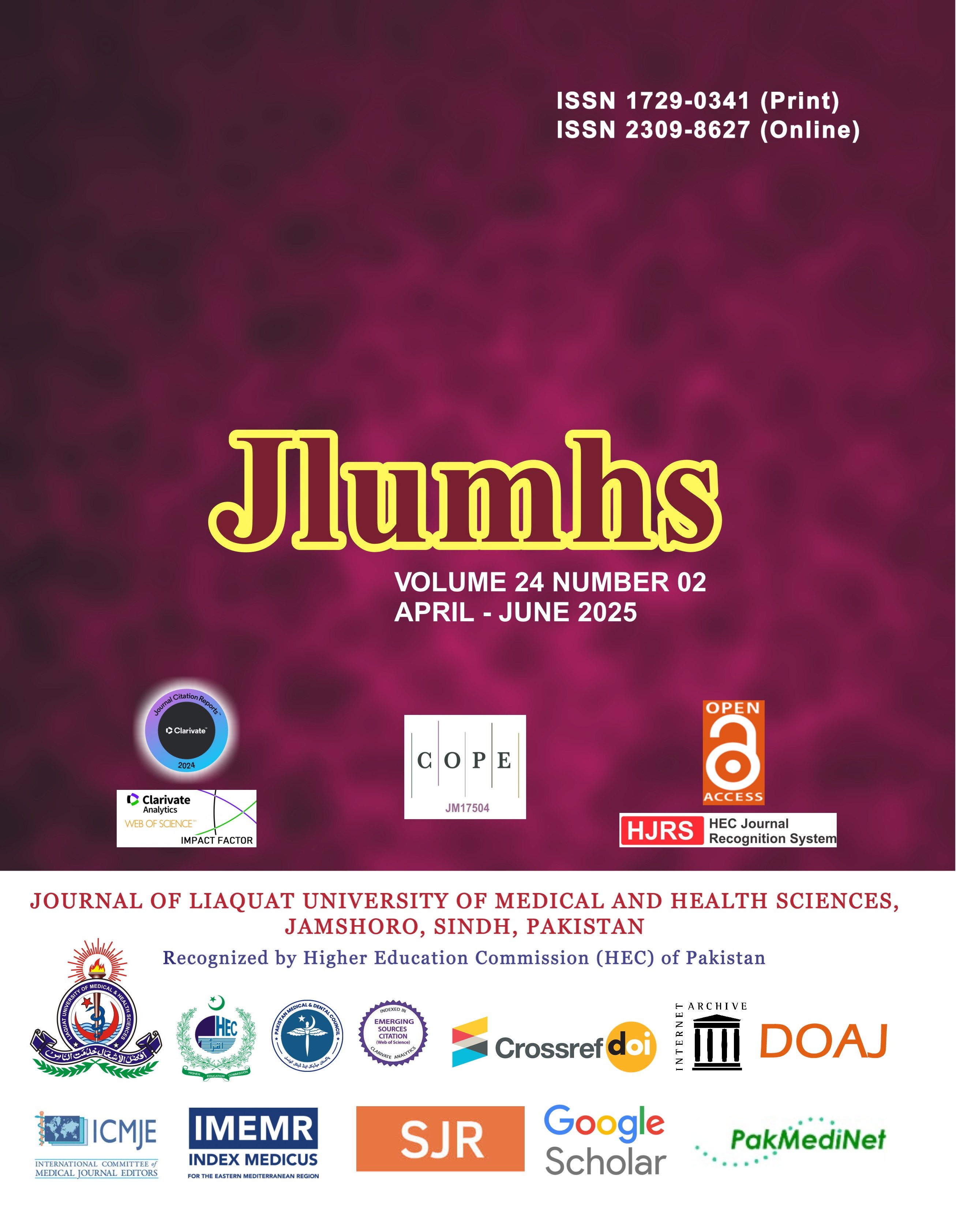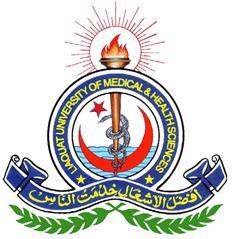CHEK2, MCM3 and MSH6 may have a Potential Role as Molecular Markers of Screening in the Detection of Cervical Premalignant and Malignant Lesions: A Scoping Review
Keywords:
Liquid based cytology, Pap smear, Cervical cancer, CHEK2, MSH6, MCM3Abstract
Lesions of the uterine cervix, including neoplasia, are the foremost cause of female deaths worldwide. Cervical malignancy ranks as the third most common gynecological malignancy globally, with an increasing prevalence reported in Asia each year. Early detection through cytology-based screening makes it one of the most preventable forms of malignancy. This review was planned to investigate the potential role of CHEK2, MCM3, and MSH6 in detecting cervical lesions. Therefore, a scoping review involved searching for published articles on databases such as PubMed, MEDLINE, EMBASE, and the Cochrane Library. According to the searched literature, several genes contribute to cervical cancer occurrence. The CHEK2 gene acts as a tumour suppressor by regulating the cell cycle pathway. At the same time, the loss of function of MSH6 leads to high rates of mutations in microsatellites, thereby deactivating the mismatch repair pathway. Moreover, the MCM3 gene's helicase activity in cell cycle regulation is overexpressed in various malignant tissues and cancer cell types. Tumor microsatellite instability (MSI) indicates the loss of mismatch repair function, which is seen in cervical cancer and reported in many other tumors. Expression of these genes may be associated with the "abnormality of the epithelial cell" term in the Bethesda system for classifying cervical lesions on cytology, ranging from atypical squamous cells to low-grade and high-grade dysplasia, which can potentially lead to invasive squamous cell carcinoma linked to transient HPV infection. Due to the scarcity of local data regarding the role of these genes in cervical malignancy, further research is crucial.
References
Mutombo Baleka A. Cervical cancer control and prevention strategies in a low-resource setting: University of Antwerp; 2019.
Cervical Cancer: Estimated cancer incidence, mortality, and prevalence worldwide in 2022 [Internet]. Available from: https://gco.iarc.who.int/media/globocan/factsheets/ populations/900-world-fact-sheet.pdf. Last cited on [12 Dec 2024].
Aoki ES, Yin R, Li K, Bhatla N, Singhal S, Ocviyanti D et al. National screening programs for cervical cancer in Asian countries. J Gynecol Oncol. 2020; 31(3): 1-9. doi: 10.3802/ jgo.2020.31.e55.
Ikram A, Khadim MT, Sohaib M, Uddin H, Badar F, Masood AI, Khattak ZI et al. National Cancer Registry of Pakistan: First Comprehensive Report of Cancer Statistics 2015-2019. J Coll Physicians Surg Pak. 2023; 33(6): 625-32. doi: 10.29271/jcpsp.2023.06.625.
Reports SKCR. Cervical Cancer Awareness Month 2021. Available from: https://shaukatkhanumorgpk/about-us/blog/cervical-cancer-2021/.
Pervez S, Jabbar AA, Haider G, Qureshi MA, Ashraf S, Lateef F et al. Karachi Cancer Registry (KCR): consolidated data of 5 years 2017-2021. J Coll Physcians Surg Pak. 2023; 1: 01. doi: 10.29271/jcpsp.2023.05.560.
Chan CK, Aimagambetova G, Ukybassova T, Kongrtay K, Azizan A. Human papillomavirus infection and cervical cancer: epidemiology, screening, and vaccination -review of current perspectives. Ann Oncol. 2019; 2019: 1-11. doi: 10.1155/2019/3257939.
Ikram A, Pervez S, Khadim MT, Sohaib M, Uddin H, Badar F et al. National cancer registry of Pakistan: first comprehensive report of cancer statistics 2015-2019. J Coll Physicians Surg Pak. 2023; 33(6): 625-32.
Al Niyazee A, Abedalrahman SK, Saleh L. Prevalence of cytological abnormality of cervical Papanicolaou smear. Middle East J Fam Med. 2019; 7(10): 16-21. doi: 10.5742/MEWFM.2019.93687.
Kashyap N, Krishnan N, Kaur S, Ghai S. Risk Factors of Cervical Cancer: A Case-Control Study. Asia Pac J Oncol Nurs. 2019; 6(3): 308-14. doi: 10.4103/apjon.apjon_73_18.
Hirani S, Khan S, Akram S, Virji SN, Shaikh PA, Naeem E et al. Knowledge, awareness, and practices of cervical cancer, its risk factors, screening, and prevention among women in Karachi, Pakistan. Eur J Cancer Prev. 2021; 30(1): 97-102. doi: 10.1097/CEJ.0000000000000590.
Nayar R, Wilbur DC. The Pap Test and Bethesda 2014. Acta Cytologica. 2015; 59(2): 121-132. doi: 10.1159/000381842.
Pankaj S, Nazneen S, Kumari S, Kumari A, Kumari A, Kumari J et al. Comparison of conventional Pap smear and liquid-based cytology: a study of cervical cancer screening at a tertiary care center in Bihar. Indian J Cancer. 2018; 55(1): 80-3. doi: 10.4103/ijc.IJC_352_17.
Varsegi GM, Shidham V. Cell block preparation from cytology specimen with predominance of individually scattered cells. J Vis Exp. 2009; 29: 1-8. doi: 10.3791/1316.
Singh U, Anjum, Qureshi S, Negi N, Singh N, Goel M et al. Comparative study between liquid-based cytology & conventional Pap smear for cytological follow up of treated patients of cancer cervix. Indian J Med Res. 2018; 147(3): 263-7.
Khan S, Omar T, Michelow P. Effectiveness of the cell block technique in diagnostic cytopathology. J Cytol. 2012; 29(3): 177-82. doi: 10.4103/ijmr.IJMR_1290_16.
Luo L, Gao W, Wang J, Wang D, Peng X, Jia Z et al. Study on the Mechanism of Cell Cycle Checkpoint Kinase 2 (CHEK2) Gene Dysfunction in Chemotherapeutic Drug Resistance of Triple Negative Breast Cancer Cells. Med Sci Monit. 2018; 24: 1-8. doi: 10.4103/0970-9371.101167.
Brooks K, Holman M, Steding C, Tucker M. A founder CHEK2 pathogenic variant in association with kidney cancer. Cancer Genet. 2022; 262: 40-2. doi: 10.1016/j.cancergen. 2021.12.007.
Motoyama N, Naka K. DNA damage tumor suppressor genes and genomic instability. Curr Opin Genet Dev. 2004; 14(1): 11-6. doi: 10.1016/j.gde.2003.12.003.
Sharifi MJ, Zaker F, Nasiri N, Yaghmaie M. Epigenetic changes in FOXO3 and CHEK2 genes and their correlation with clinicopathological findings in myelodysplastic syndromes. Hematol Oncol Stem Cell Ther. 2020; 13(4): 214-9. doi: 10.1016/j.hemonc.2019. 11.004.
Consortium APG. AACR Project GENIE: powering precision medicine through an international consortium. Cancer Discov. 2017; 7(8): 818-831. doi: 10.1158/2159-8290.CD-17-0151.
Banaszkiewicz M, Constantinou M, Pietrusi?ski M, K?pczy?ski L, J?drzejczyk A, Ro?niecki M et al. Concomitance of oncogenic HPV types, CHEK2 gene mutations, and CYP1B1 gene polymorphism as an increased risk factor for malignancy. Cent European J Urol. 2013; 66(1): 23-9. doi: 10.5173/ceju.2013.01.art7.
Liu J, Zheng B, Li Y, Yuan Y, Xing C. Genetic Polymorphisms of DNA Repair Pathways in Sporadic Colorectal Carcinogenesis. J Cancer. 2019; 10(6): 1-17. doi: 10.7150/jca. 28406.
Modrich P, Lahue R. Mismatch repair in replication fidelity, genetic recombination, and Cancer Biology. Ann Rev Biochem. 1996; 65(1): 101-33. doi: 10.1146/annurev. bi.65.070196.000533.
Mendoza RP, Haidary T, Gabutan E, Zhou YY, Bukhari Z, Connelly C et al. Mixed and nonvaccine high risk HPV types are associated with higher mortality in Black women with cervical cancer. Sci Rep. 2021; 11(1): 1-14. doi: 10.1038/s41598-021-93485-1.
Antill YC, Dowty JG, Win AK, Thompson T, Walsh MD, Cummings MC et al. Lynch syndrome and cervical cancer. Int J Cancer. 2015; 137(11): 2757-61. doi: 10.1002/ijc.29547.
Ha S-A, Shin SM, Namkoong H, Lee H, Cho GW, Hur SY et al. Cancer-associated expression of minichromosome maintenance 3 gene in several human cancers and its involvement in tumorigenesis. Clin Cancer Res. 2004; 10(24): 8386-95. doi: 10.1158/1078-0432.CCR-04-1029.
Yu S, Wang G, Shi Y, Xu H, Zheng Y, Chen Y. MCMs in Cancer: Prognostic Potential and Mechanisms. Anal Cell Pathol. 2020; 2020: 1-11. doi: 10.1155/2020/3750294.
Wu B, Xi S. Bioinformatics analysis of the transcriptional expression of minichromosome maintenance proteins as potential indicators of survival in patients with cervical cancer. BMC Cancer. 2021; 21(1): 1-17. doi: 10.1186/s12885-021-08674-y.
McGowan J, Straus S, Moher D, Langlois EV, O'Brien KK, Horsley T et al. Reporting scoping reviews-PRISMA ScR extension. J Clin Epidemiol. 2020; 123(177): e9. doi: 10.1016/ j.jclinepi.2020.03.016.
Buccheri RK SC. Critical appraisal tools and reporting guidelines for evidence?based practice. Worldviews on Evidence?Based Nursing. Critical Appraisal Tools and Reporting Guidelines for Evidence-Based Practice. 2017; 14(6): 463-472. doi: 10.1111/wvn.12258.
Guo F LR, Kong W, Anwar M, Feng Y. DNA mismatch repair system regulates the expression of PD-L1 through DNMTs in cervical cancer. Cancer Cell Int. 2024; 24(1): 25-41. doi: 10.1186/s12935-024-03214-7.
Kazanci F, Çelik ZY, Polat M, Karademir F, Erdem O, ?ahin F? et al. Homologous recombination deficiency gene panel analysis results in synchronous endometrial and ovarian cancers. Rev Assoc Med Bras. 2024; 70(10): e20240534. doi: 10.1590/1806-9282.20240534.
Ozdemir O, Bychkovsky BL, Unal B, Onder G, Amanvermez U, Aydin E et al. Molecular and In Silico Analysis of the CHEK2 Gene in Individuals with High Risk of Cancer Predisposition from Türkiye. Cancers. 2024; 16(22): 3876. doi: 10.3390/cancers16223876.
Addante F, d’Amati A, Santoro A, Angelico G, Inzani F, Arciuolo D et al. Mismatch Repair Deficiency as a Predictive and Prognostic Biomarker in Endometrial Cancer: A Review on Immunohistochemistry Staining Patterns and Clinical Implications. Int J Mol Sci. 2024; 25(2): 1056. doi: 10.3390/ijms25021056.
Wu B, Xi S. Bioinformatics analysis of differentially expressed genes and pathways in the development of cervical cancer. BMC Cancer. 2021; 21(1): 733. doi: 10.1186/s12885-021-08412-4.
Ma H, Liu Z, Li H, Guo X, Guo S, Qu P et al. Bioinformatics analysis reveals MCM3 as an important prognostic marker in cervical cancer. Computational and mathematical methods in medicine. 2021; 2021(1): 8494260. doi: 10.1155/2021/8494260.
Zheng J. Diagnostic value of MCM2 immunocytochemical staining in cervical lesions and its relationship with HPV infection. Int J Clin Exp Pathol. 2015; 8(1): 875-80.
G?sior-Perczak D, Kowalik A, Kopczy?ski J, Macek P, Niemyska K, Walczyk A et al. Relationship between the Expression of CHK2 and p53 in Tumor Tissue and the Course of Papillary Thyroid Cancer in Patients with CHEK2 Germline Mutations. Cancers. 2024; 16(4): 815. doi: 10.3390/cancers16040815.
Kuhlen M ST, Dintner S, Stadler N, Hofmann TG, Schmutz M, Claus R et al. Double heterozygous pathogenic variants in TP53 and CHEK2 in boy with undifferentiated embryonal sarcoma of the liver. Int J Mol Sci. 2024; 25(21): 11489-96. doi: 10.3390/ijms252111489.
Tous C, Muñoz-Redondo C, Bravo-Gil N, Gavilan A, Fernández RM, Antiñolo J et al. Identification of Novel Candidate Genes for Familial Thyroid Cancer by Whole Exome Sequencing. Int J Mol Sci. 2023; 24(9): 7843. doi: 10.3390/ijms24097843.
He N, Bao LR, Fu ZI, Gao WN, Wang JY, Chen LG. MSH6 as a prognostic biomarker in bladder cancer and its correlation with immunity. 2024. doi: 10.21203/rs.3.rs-4930584/v1.
Downloads
Published
How to Cite
Issue
Section
License
Copyright (c) 2025 Journal of Liaquat University of Medical & Health Sciences

This work is licensed under a Creative Commons Attribution-NonCommercial-ShareAlike 4.0 International License.
Submission of a manuscript to the journal implies that all authors have read and agreed to the content of the undertaking form or the Terms and Conditions.
When an article is accepted for publication, the author(s) retain the copyright and are required to grant the publisher the right of first publication and other non-exclusive publishing rights to JLUMHS.
Articles published in the Journal of Liaquat University of Medical & health sciences are open access articles under a Creative Commons Attribution-Noncommercial - Share Alike 4.0 License. This license permits use, distribution and reproduction in any medium; provided the original work is properly cited and initial publication in this journal. This is in accordance with the BOAI definition of open access. In addition to that users are allowed to remix, tweak and build upon the work non-commercially as long as appropriate credit is given and the new creations are licensed under the identical terms. Or, in certain cases it can be stated that all articles and content there in are published under creative commons license unless stated otherwise.























